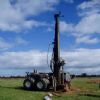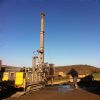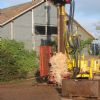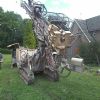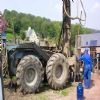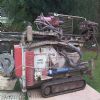Borehole drilling
Once the surface water requirements are known and an assessment either by a hydrogeologist, water diviner or an examination of geological maps has been undertaken the borehole can be drilled according to the information found. Typically, a borehole used as a water well is completed by installing a vertical pipe (casing) and well screen to keep the borehole from caving in. Drilled wells are typically created using either top-head rotary style, table rotary, or cable tool drilling machines, all of which use drilling stems that are turned to create a cutting action in the formation, hence the term 'drilling'. Once the surface water requirements are known and an assessment either by a hydrogeologist, water diviner or an examination of geological maps has been undertaken the borehole can be drilled according to the information found. Typically, a borehole used as a water well is completed by installing a vertical pipe (casing) and well screen to keep the borehole from caving in. Drilled wells are typically created using either top-head rotary style, table rotary, or cable tool drilling machines, all of which use drilling stems that are turned to create a cutting action in the formation, hence the term 'drilling'. nosnvvnOnce the surface water requirements are known and an assessment either by a hydrogeologist, water diviner or an examination of geological maps has been undertaken the borehole can be drilled according to the information found. Typically, a borehole used as a water well is completed by installing a vertical pipe (casing) and well screen to keep the borehole from caving in. Drilled wells are typically created using either top-head rotary style, table rotary, or cable tool drilling machines, all of which use drilling stems that are turned to create a cutting action in the formation, hence the term 'drilling'. Once the surface water requirements are known and an assessment either by a hydrogeologist, water diviner or an examination of geological maps has been undertaken the borehole can be drilled according to the information found. Typically, a borehole used as a water well is completed by installing a vertical pipe (casing) and well screen to keep the borehole from caving in. Drilled wells are typically created using either top-head rotary style, table rotary, or cable tool drilling machines, all of which use drilling stems that are turned to create a cutting action in the formation, hence the term 'drilling'. Once the surface water requirements are known and an assessment either by a hydrogeologist, water diviner or an examination of geological maps has been undertaken the borehole can be drilled according to the information found. Typically, a borehole used as a water well is completed by installing a vertical pipe (casing) and well screen to keep the borehole from caving in. Drilled wells are typically created using either top-head rotary style, table rotary, or cable tool drilling machines, all of which use drilling stems that are turned to create a cutting action in the formation, hence the term 'drilling'. Once the surface water requirements are known and an assessment either by a hydrogeologist, water diviner or an examination of geological maps has been undertaken the borehole can be drilled according to the information found. Typically, a borehole used as a water well is completed by installing a vertical pipe (casing) and well screen to keep the borehole from caving in. Drilled wells are typically created using either top-head rotary style, table rotary, or cable tool drilling machines, all of which use drilling stems that are turned to create a cutting action in the formation, hence the term 'drilling'. Once the water requirements are known and an assessment, either by a hydrogeologist, water diviner or an examination of geological maps, has been undertaken the borehole can be drilled according to the information found. Typically, a borehole used as a water well is completed by installing a vertical pipe (casing) and well screen to keep the borehole from caving in. Drilled wells are typically created using either top-head rotary style, table rotary, or cable tool drilling machines, all of which use drilling stems that are turned to create a cutting action in the formation, hence the term 'drilling'.
Boreholes can vary in depth and design depending upon the level of the water table, the quantity of water stored in the ground and the requirements of the customer; typically they are between 60-120 vertical metres. In basic terms there are usually two pipes involved in the final borehole installation – an outer metal pipe (casing), and a plastic MDPE (WRAS approved) inner pipe which slides down inside it, the lower segments of the pipe are slotted to allow water ingress. Normally the inner pipe is at least 4" in diameter to accommodate a 3” or 4” borehole pump and must be surrounded by gravel to prevent dirt clogging up the plastic pipe then sealed near the surface using a special grout. This grout usually goes down as far as the impermeable layer and is designed to prevent contamination from surface water entering the borehole. The outer metal casing pipe is usually at least 6" diameter to accommodate all this.
Will there be water?
If a preliminary assessment has been undertaken, or local knowledge and/or a water diviner is used, there is an increased chance of finding water suitable for your requirements. However, drilling any borehole involves a risk, this may mean the borehole is drilled deeper than expected, the water is not of the expected quality or a suitable quantity of water is not found. Whilst we are not trying to put people off the idea of a borehole (far from it) it is important to bear in mind that these are all ‘real’ possibilities when drilling a borehole and as such we strongly recommend a hydrogeological assessment and seeking the assurance of your drilling contractor and checking their terms and conditions.
We have partnered with a number of specialist drilling companies in the past however as an independent company we are able to recommend the driller best suited to your requirements.
| Further information is available |

|
|
Related images in this section
Click for a larger image and description |
|
|


